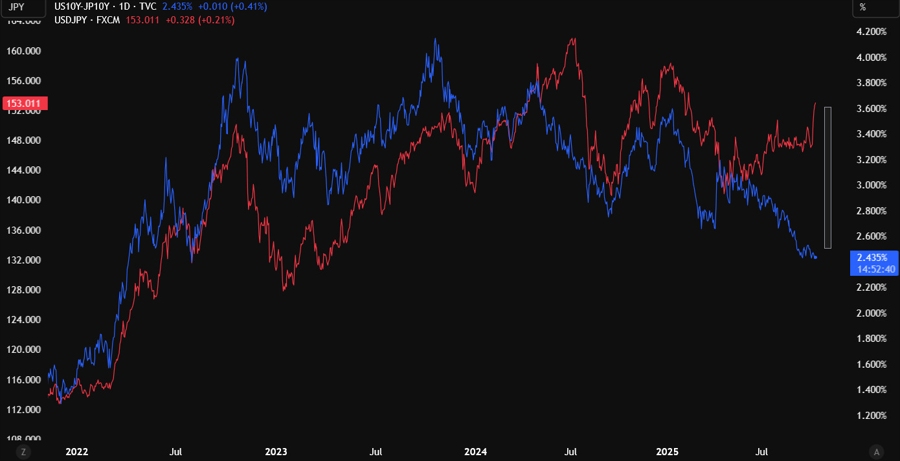Major currency pairs are driven primarily by yield differentials between the respective countries. The basic idea is that investors care about the return they can earn on cash or bonds in one country versus another. So, if US yields are higher than Japanese yields, holding dollars is more attractive than holding yen, and this capital flow can push up the USDJPY pair. Conversely, if Japanese yields are higher than US yields, holding yen becomes more attractive.
Bond yields are mainly driven by expectations of monetary policy, so it's not the current yield that investors care about but the future yield based on central bank policy expectations. The yield differential is not the only driver of currency pairs but it's the most influential one and explains 90% of FX moves.
Now, in the picture below, you can see that there's currently a huge divergence between the US-Japan yield differential and the USDJPY pair.

The last time we had such a big divergence was in July 2024. The FX pair eventually caught up with the yield differential with an aggressive move. It started with an intervention on July 11 that propped up the yen. Then we got reports of a potential BoJ rate hike. Then we got the "unexpected" BoJ hike on July 31. And finally, we got the growth scare on August 2 triggered by a weak US NFP report.
Today, the divergence has been driven by a few factors but the main ones have been overstretched US dollar shorts and BoJ pushbacks on rate hikes. The US dollar shorts started to get unwound as we reached the peak in rate cuts pricing for the Fed and some better than expected US data propped up the dollar further. Now, with the US government shutdown we are not getting the data needed to reprice further and if we get another soft NFP report or a benign US CPI, then the pricing will not change much.
On the Japanese yen side, the BoJ surprised at the last meeting as two members voted for a rate hike and gave the JPY a boost. At the press conference though, Governor Ueda played down the dissenting votes and the yen eventually erased the gains. Lastly, the victory of Takaichi over the weekend sinked the JPY further as markets expected more expansionary fiscal policy and another delay in rate hikes.
The markets might be having an Abe-Kuroda deja-vu, but today's context is different in my opinion. In fact, we are not coming out of a global financial crisis, and Japan is not fighting against deflation. Just these two are enough to see that the context is very different. What weighed on business sentiment this year were Trump's tariffs.
Despite the tariffs though, the Japanese Q2 growth was revised sharply higher recently and the Tankan survey (which is what the BoJ has been focusing on) showed that confidence among big Japanese manufacturers improved for the second straight quarter and firms maintained their upbeat spending plans. Moreover, Takaichi is expected to increase government spending and that should support growth further.
There are expectations of a JPY intervention given the aggressive selloff this week. This is something to watch out for as it could mark a short-term top in the USDJPY pair. The BoJ might also decide to pre-emptively hike rates at the upcoming meeting, so keep an eye on the news as we could get "leaks" before the actual meeting and the market will of course position into the rate hike in advance. Right now, the market is pricing just a 27% probability of a hike in October and less than 50% chance of a rate hike before year-end.



